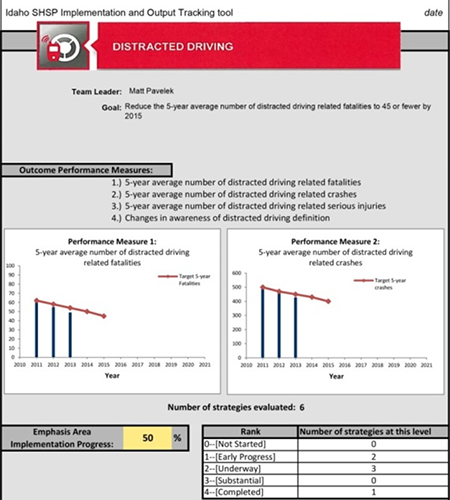|
Search the Noteworthy Practices database Idaho Builds Evaluation into its Strategic Highway Safety PlanThe Idaho practice is discussed after the following introduction about Strategic Highway Safety Plan (SHSP) evaluation.Other states in this SHSP Evaluation Noteworthy Practices series: NV and WA Publication Year: 2015Planning for Evaluation Should Begin When the SHSP is DevelopedThe Highway Safety Improvement Program (HSIP) requires States to evaluate their Strategic Highway Safety Plan (SHSP) to ensure the accuracy of their SHSP priorities and proposed strategies. Furthermore, evaluation helps States answer basic questions about the progress of their SHSP such as:
States that have successfully integrated evaluation into their SHSP process have realized the opportunity it provides to strengthen their SHSP efforts. Benefits include demonstrating the SHSP's contribution to transportation safety; uncovering challenges in prioritizing or implementing programs and strategies; determining progress in meeting SHSP goals and objectives, and; validating emphasis areas and strategies, or revealing the need to revise them. Following are examples of how States have put evaluation into action.
It is never too early to institute evaluation; in fact, planning for evaluation should begin when the SHSP is developed. During the early stages of SHSP development attention should be given to how progress will be measured and success determined. Idaho's PracticeIdaho Develops an Evaluation PlanRecognizing the importance of SHSP evaluation, Idaho embarked on the development of an evaluation plan in the early stages of their 2013-2016 SHSP. To develop the evaluation approach, the Idaho Transportation Department (ITD) convened a two-day workshop that included the input of Focus Group Committee Chairs, the SHSP Executive Oversight Team, the Office of Highway Safety Manager, the SHSP Manager, and FHWA. During the workshop, the evaluation team identified performance measures for emphasis area goals and objectives as well as for priority strategies. The team determined the data they would need to monitor their progress, established a tracking tool, and assigned roles and responsibilities for the various evaluation components. These elements are captured in an evaluation plan document that the team will continue to reference over the life of their SHSP. The Focus Group Chairs are taking the lead on tracking SHSP implementation and monitoring progress towards goals and objectives. Their tracking tool generates a summary sheet, which is used to inform leadership and to report on their progress at their regular SHSP team and committee meetings. In general, their evaluation results are used to monitor progress and identify areas of success as well as those needing improvement. Modifications will be made as warranted. Results are also used to:
Figure 1. Idaho SHSP Implementation and Output Tracking Tool 
See these other SHSP Evaluation Noteworthy Practices:ContactLisa Losness Publication Year: 2015 |